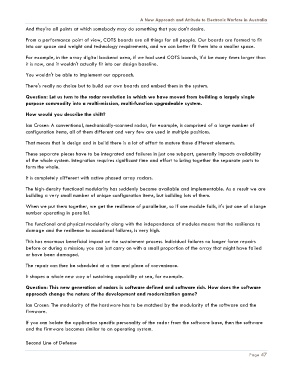Page 48 - Williams Foundation Future of Electronic Warfare Seminar
P. 48
A New Approach and Attitude to Electronic Warfare in Australia
And they're all points at which somebody may do something that you don't desire.
From a performance point of view, COTS boards are all things for all people. Our boards are formed to fit
into our space and weight and technology requirements, and we can better fit them into a smaller space.
For example, in the array digital backend area, if we had used COTS boards, it'd be many times larger than
it is now, and it wouldn't actually fit into our design baseline.
You wouldn't be able to implement our approach.
There's really no choice but to build our own boards and embed them in the system.
Question: Let us turn to the radar revolution in which we have moved from building a largely single
purpose commodity into a multi-mission, multi-function upgradeable system.
How would you describe the shift?
Ian Croser: A conventional, mechanically-scanned radar, for example, is comprised of a large number of
configuration items, all of them different and very few are used in multiple positions.
That means that in design and in build there is a lot of effort to mature those different elements.
These separate pieces have to be integrated and failures in just one subpart, generally impacts availability
of the whole system. Integration requires significant time and effort to bring together the separate parts to
form the whole.
It is completely different with active phased array radars.
The high-density functional modularity has suddenly become available and implementable. As a result we are
building a very small number of unique configuration items, but building lots of them.
When we put them together, we get the resilience of parallelism, so if one module fails, it's just one of a large
number operating in parallel.
The functional and physical modularity along with the independence of modules means that the resilience to
damage and the resilience to occasional failures, is very high.
This has enormous beneficial impact on the sustainment process. Individual failures no longer force repairs
before or during a mission; you can just carry on with a small proportion of the array that might have failed
or have been damaged.
The repair can then be scheduled at a time and place of convenience.
It shapes a whole new way of sustaining capability at sea, for example.
Question: This new generation of radars is software defined and software rich. How does the software
approach change the nature of the development and modernization game?
Ian Croser: The modularity of the hardware has to be matched by the modularity of the software and the
firmware.
If you can isolate the application specific personality of the radar from the software base, then the software
and the firmware becomes similar to an operating system.
Second Line of Defense
Page 47

